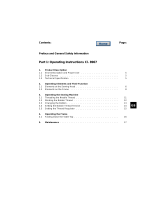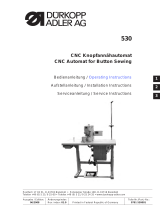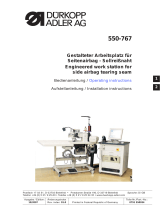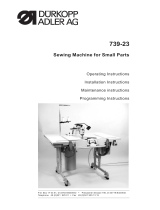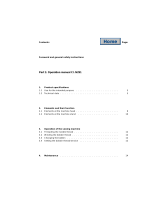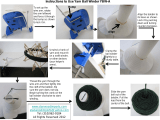Page is loading ...

Contents Page:
Preface and General Safety Information
Part 1: Operating Instructions Cl. 381 - 382
1. Product Description
. . . . . . . . . . . . . . . . . . . . . . . . . . . 5
2. Proper Use
. . . . . . . . . . . . . . . . . . . . . . . . . . . . . . . . . 5
3. Subclasses
. . . . . . . . . . . . . . . . . . . . . . . . . . . . . . . . . 6
4. Optional Equipment
. . . . . . . . . . . . . . . . . . . . . . . . . . . . 6
5. Technical Data
. . . . . . . . . . . . . . . . . . . . . . . . . . . . . . . 7
6. Operation
6.1 Threading the Needle Thread . . . . . . . . . . . . . . . . . . . . . . . 9
6.2 Setting the Needle Thread Tension . . . . . . . . . . . . . . . . . . . . 11
6.3 Opening the Needle Thread Tension . . . . . . . . . . . . . . . . . . . 11
6.4 Setting the Tension Regulator . . . . . . . . . . . . . . . . . . . . . . . 12
6.5 Winding the Underthread . . . . . . . . . . . . . . . . . . . . . . . . . 13
6.6 Inserting the Underthread Bobbin . . . . . . . . . . . . . . . . . . . . . 14
6.7 Setting the Underthread Tension . . . . . . . . . . . . . . . . . . . . . 15
6.8 Inserting and Changing Needles . . . . . . . . . . . . . . . . . . . . . 16
6.9 Lifting the Sewing Feet . . . . . . . . . . . . . . . . . . . . . . . . . . . 17
6.10 Arresting the Sewing Feet in the High Position . . . . . . . . . . . . . . 17
6.11 Setting the Sewing Foot Pressure . . . . . . . . . . . . . . . . . . . . . 18
6.12 Stitch Length on Sewing Machines without Automatic Bartacking . . . 19
6.12.1 Stitch Length on Sewing Machines with Automatic Bartacking . . . . . 20
6.13 Switching the Needle Bars On and Off . . . . . . . . . . . . . . . . . . 21
6.14 Roller Top Feed . . . . . . . . . . . . . . . . . . . . . . . . . . . . . . . 22
7. Controls and Control Panel
7.1 General . . . . . . . . . . . . . . . . . . . . . . . . . . . . . . . . . . . 23
7.2 Keys on the Control Panel . . . . . . . . . . . . . . . . . . . . . . . . . 24
7.3 Changing the Parameter Values . . . . . . . . . . . . . . . . . . . . . . 25
7.4 "Operator Level" Parameter List . . . . . . . . . . . . . . . . . . . . . . 26
7.5 Key Bank on the Machine Arm . . . . . . . . . . . . . . . . . . . . . . . 27
8. Sewing
. . . . . . . . . . . . . . . . . . . . . . . . . . . . . . . . . . . 28
Home

1. Product Description
The
DÜRKOPP ADLER 381 - 382
are special sewing machines for first-class
two-needle decorative seams.
•
Two-needle flat bed double-saddle-stitch machine with bottom and needle feed.
The needles can be turned on and off.
•
Class
382
additionally with roller top feed.
•
Slit presser bar (international standard), thus allowing normal commercial sewing
devices to be used.
•
Existing sewing devices of class 380 can be used.
•
Central oil wick lubrication with visible reserve in the arm.
Manual hook lubrication.
•
Integrated winder.
•
Integrated adjustment disk.
2. Proper Use
The
381 - 382
are special sewing machines which can properly be used for sewing light
sewing material. Such material is, as a rule, fabric composed of textile fibers or leather.
These sewing materials are used in the garment and furniture industries.
Furthermore, it may be possible to also execute so-called technical seams with this
special sewing machine. Here, however, the operator (
DÜRKOPP ADLER AG
would be
pleased to help) must make an evaluation of the possible dangers since such
applications are, on the one hand, relatively rare and, on the other, their variety is
immense. Depending on the results of this evaluation it may be necessary to adopt
appropriate safety measures.
In general, only dry material may be worked with this special machine. The material
may not be thicker than 8 mm when it is pressed together by the lowered sewing feet.
The material may contain no hard objects because otherwise the sewing unit could only
be allowed to be operated with eye protection.
Such eye protection is not available at this time.
The seam is generally made with sewing yarns of textile fibers with dimensions up to
30/2 Nm (synthetic threads) or 30/3 Nm (core spun threads). Those wishing to use
other threads must also first evaluate the dangers arising herefrom and, if necassary,
take safety measures.
This special sewing machine may only be installed and operated in dry and clean areas.
If the sewing unit is employed in other areas, which are not dry and clean, other, to be
agreed upon, measures may become necessary (see EN 60204-3-1: 1990).
We, as a manufacturer of industrial sewing machines, assume that, at a minimum,
semi-skilled operating personel work on our products so that all normal operations and,
where applicable, their dangers can be presumed to be known.
5

3. Subclasses
Cl. 381 - 160161:
Two-needle flat bed double-saddle-stitch machine with switchable
needles, bottom and needle feed, electromagnetic thread trimmer.
Cl. 381 - 160162:
as Cl. 381 - 160161, additionally with electropneumatic automatic
bartacking and electropneumatic sewing foot lift.
Cl. 382 - 160162
: as Cl. 381 - 160162, additionally with roller top feed
4. Optional Equipment
Order no. Optional Equipment
9822 510001
Sewing light (halogen) WALDMANN,
with 12V/20W lamp, to be attached to the sewing machine head.
OAPP 1241
Sewing light mounting kit, for 9822 510001.
0798 500088
Sewing light transformer
For 230V, with mains cable, without switch,
for sewing lights 9822 510001.
9780 000108
Maintenance unit WE 8
For pneumatic optional equipment.
0797 003031
Pneumatic connection package
For the pneumatic connection of frames with maintenance unit
and pneumatic optional equipment.
Consisting of connection hose (length 5 m, diameter 9 mm),
hose nozzles, hose clamps, coupling socket and coupling
plug.
0381 590014
Electromagnetic thread wiper for Cl. 381
0382 590014
Electromagnetic thread wiper for Cl. 382
N900 001941
Swing rail for apparatus
N900 011038
Edge stop-right, on base plate, fixed
N900 012015
Edge stop-right, on base plate, swing-down
N900 020039
Edge stop-right, on the sewing machine head, swing-up
6

5. Technical Data
Noise level:
Work station relevant emission value
to DIN 45635-48-A-1-KL2
Cl. 381 - 160161
Lc = __ dB (A)
Stitch length: __ mm
Number of stitches: 3 000 [min-1]
Material: ___________________
Cl. 381 - 160162
Lc = ___ dB (A)
Stitch length: __ mm
Number of stitches: 3 000 [min-1]
Material: ________________
Cl. 382 - 160162
Lc = __ dB (A)
Stitch length: __ mm
Number of stitches: 3 000 [min-1]
Material: ________________
The values were not available at press time !
7

Needle system: 797
Needle thickness (depending on E no.): [Nm] (70 to 110) 90
Seam width / needle clearance: [mm] 4.8 11.9 (25.4)
(depending on E no.)
Max. sewing thread thicknesses:
- Synthetic sewing thread [Nm] 30/2
- Core spun thread [Nm] 30/3
Max. number of stitches: [min
-1
] 3 000 *
Max. stitch length:
- Forward: [mm] (2 400 stitches/min) 6 *
- Reverse: [mm] (2 400 stitches/min) 6 *
Max. sewing foot stroke: [mm] 10 (Cl. 381)
9 (Cl. 382)
Feed dog stroke: [mm]
(above the needle plate) 1.1
Max. opening under the sewing feet:
- Sewing [mm] 8
- Raised [mm] 10
Operating pressure: [bar] 6
Air consumption per work cycle: approx. [NL] 0.02
Design voltage: 1 x 230 V, 50 / 60 Hz
Dimensions (H x W x D): [mm] 1750 x 1060 x 500
(depending on table top) 1750 x 1060 x 600
1750 x 1250 x 900
Work height (ex works): [mm] 790
Weight (only machine head): approx.[kg] 40
* At max. stitch length the number of stitches must be reduced to 2 400 stitches/min.
8

6. Operation
6.1 Threading the Needle Thread
Caution Risk of Injury !
Turn the main switch off !
Thread the needle thread only with the sewing machine
turned off.
–
Place the yarn spools on the yarn stand as shown in the illustration and guide the
needle and underthreads through the take-off arms.
The take-off arms 1 and 3 must lie vertically above the yarn spools.
The take-off arms 2 and 4 are to be set as per the drawing.
They prevent the two needle threads from hitting each other.
–
Thread the needle thread as per the drawing on
page 10
.
P
variocontrol 720
0
98
7
32
1
45
6
E
+
3
4
1
2
9

6.2 Setting the Needle Thread Tension
Main tension 3
The main tension 3 is to be set as low as possible.
The interlacing of the threads should lie in the middle of the material (see Illus. a ).
Too high thread tensions can lead to unwanted bunching in thin material and thread
breakage.
–
Set the main tension 3 so that a uniform stitch pattern is achieved.
Supplimentary tension 2
The switchable supplimentary tension 2 serves for the quick change of the needle
thread tension, e.g. at seam thickenings.
–
Set the supplimentary tension 2 lower than the main tension 3.
–
Turn the supplimentary tension 2 on or off with lever 1.
0 = Supplimentary tension 2 is turned off.
1 = Supplimentary tension 2 is turned on.
6.3 Opening the Needle Thread Tension
Automatic
The needle thread tension is automatically opened during thread trimming.
Note
The timing of the thread tension opening can be set with the parameters F-191 and
F-192 (technician level).
Manual
The main and supplimentary tensions can be opened by hand through pressure on
A
.
11

6.4 Setting the Tension Regulator
The needle thread quantity required for the hook is adjusted with the tension regulator 2.
The setting is dependent on the following factors: - Material thickness
- Yarn characteristics
- Stitch length
A prescisely set tension regulator assures an optimal sewing result at the lowest
possible needle thread tension.
With a correct setting, the needle thread loop must glide over the thickest point of the
hook with little tension.
In position "
1
" of the tension regulator the maximum thread quantity is released.
In position "
5
" of the tension regulator the minimum thread quantity is released.
Caution Risk of Injury !
Set tension regular 2 only with the sewing machine turned
off.
–
Loosen screws 1 and 3.
–
Alter the position of the tension regulator 2.
The scale above the tension regulator serves as a setting aid.
–
Tighten screws 1 and 3.
Setting note:
For a correct setting of the tension regulator 2 the following condition must be met:
–
When the greatest thread quantity is required, the thread controller spring 4 must
be pulled approx. 0.5 mm up out of its upper end position.
This is the case when the needle thread loop passes the maximum diameter of the
hook.
1
2
3
4
12

6.5 Winding the Underthread
–
Thread the underthread as shown in the illustrations.
–
Place the bobbin on the winder shaft 2.
–
Wind the underthread counterclockwise approx. 5x around the bobbin core.
–
Tear off the underthread at thread clamp 3.
–
Swing the winder lever 4 against the bobbin.
–
Set the tension 1.
The underthread should be wound up uniformly with little tension.
–
Bend the guide plate 5.
The bobbin should be filled cylindrically and not conically.
–
Set screw 6.
The winder should shut off automatically at the correct time, this means, when the
winding diameter is 0.5 mm smaller than the bobbin diameter.
–
Sewing.
Winder lever 4 ends the procedure as soon as the bobbin is full.
2 3
4 6
5
1
13

6.6 Inserting the Underthread Bobbin
Caution Risk of Injury !
Turn the main switch off.
Change the underthread bobbins only with the sewing
machine turned off.
Removing the empty underthread bobbin
–
Bring the needle bars into the high position.
–
Open the needle plate slides 1 and 2.
Unlock the right needle plate slide 2 by pressing down on the leaf spring 3.
–
Lift the bobbin case flap.
–
Remove the bobbin case with empty underthread bobbin.
Threading the underthread
–
Insert a full bobbin 4 into bobbin case 7:
When the thread is being drawn off, the bobbin must turn in the direction of the arrow.
–
Pull the underthread through slit 5 under tension spring 6.
–
Thread the underthread through hole 8 in the bobbin case top.
This assures the
thread trimming
function.
–
Cut off the underthread up to approx. 3 cm.
–
Insert the bobbin case top with full bobbin into the hook.
–
Close the bobbin case flap.
–
Close the needle plate slides 1 and 2 again.
1 2 3
5 6 7 8
4
14

6.7 Setting the Underthread Tension
Caution Risk of Injury !
Turn the main switch off.
Set the underthread tension only with the sewing machine
turned off.
–
Take out the bobbin case with bobbin.
–
To lift the bobbin case reach under the nose 3.
–
Set tension spring 2 by turning the adjustment screw 1.
–
Insert the bobbin case with bobbin into the hook again.
Note:
The spring 4 is to be found under the bobbin in the hook.
When thread trimming the underthread automatically it prevents a "running-on" of the
bobbin.
ATTENTION !
The spring 4 must always be in the bobbin case in the
position shown in the sketch.
The spring 4 should not be lost during cleaning work.
1 2 3 4
15

6.8 Inserting and Changing Needles
Caution Risk of Injury !
Turn the main switch off.
Change needles only with the sewing machine turned off.
–
Bring the needle bars into the high position.
–
Loosen screws 1 (right or left, 1.5 Allan key in the accessories pack).
–
Remove the needles from the needle holder.
–
Insert new needles up to the stop in the holes of the needle holder.
ATTENTION !
Seen from the operator side, the furrow of the left needle
must face to the left and the furrow of the right needle to the
right.
–
Tighten screws 1 (right or left).
ATTENTION !
The factory-set clearance of the hook to the needle is only
correct for needles with a thickness of Nm 80 to 100. When
inserting a thinner or thicker needle, the clearance must be
corrected (see Service Instructions).
Non-observance of the above correction can lead to the following errors:
When inserting thinner needles: - Missing stitches
- Damage to the thread
When inserting thicker needles: - Damage to the hook point
- Damage to the needle
1
1
16

6.9 Lifting the Sewing Feet
The sewing feet can be raised mechanically or pneumatically.
Depending on the equipment of the special sewing machine, the lifting occurs through
operation of the knee lever 2 or the stepping back on the pedal.
Mechanical sewing foot lift (knee lever 2)
–
To move the material (e.g. for corrections) operate knee lever 2.
The sewing feet remain raised as long as the knee lever 2 is operated.
Pneumatic sewing foot lift (pedal)
–
Step halfway back on the pedal.
The sewing feet rise when the machine stops.
–
Step the pedal completely to the back.
Activate the thread trimmer and lift the sewing feet.
6.10 Arresting the Sewing Feet in the High Position
The mechanically or pneumatically lifted sewing feet can be arrested in the high
position with button 1 (e.g. for winding the underthread).
–
With the sewing machine stopped step half back on the pedal or operate the knee
lever.
The sewing feet rise.
–
Press button 1 and release the pedal or knee lever.
The raised sewing feet are arrested in the high position.
–
Step half back on the pedal or operate the knee lever again.
The arresting of the sewing feet is cancelled.
0
I
P
variocontrol 720
0
98
7
32
1
45
6
E
+
1
2
17

6.11 Setting the Sewing Foot Pressure
The desired sewing foot pressure is set with sleeve 1.
–
Increase sewing foot pressure = Turn sleeve 1 clockwise.
Decrease sewing foot pressure = Turn sleeve 1 counterclockwise.
The setting range can be changed by turning the bolt 2.
–
Screw off sleeve 1.
–
Take out bolt 2, turn and insert again.
Fitting position
A
= Higher sewing foot pressure.
Fitting position
B
= Lower sewing foot pressure.
–
Replace sleeve 1 again and set the desired sewing foot pressure.
1
2
A B
18

6.12 Stitch Length on Sewing Machines without Automatic Bartacking
The desired stitch length is set with the knurled nut 1 in the stitch regulator lever.
It is the same for forward and reverse sewing.
Changing the stitch length during sewing.
With the stitch regulator lever 2 the stitch length can be continuously changed during
sewing between the set forward and reverse stitch length.
–
Stitch regulator lever all the way up.
Forward sewing with the set stitch length.
–
Stitch regulator lever all the way down.
Reverse sewing with the set stitch length.
variocontrol 720
8
7
45
1
2
19

6.12.1 Stitch Length on Sewing Machines with Automatic Bartacking
Sewing machines with automatic bartacking
( Subclass 381-160162 and 382-160162 )
On sewing machines with automatic bartacking the stitch lengths are set with the
knurled nut 3 and the block 1.
The knurled nut in the stitch regulator lever (see pos. 1 page 19) is turned completely
back.
Caution Risk of Injury !
Turn the main switch off.
Set the stitch length only with the sewing machine turned off.
–
Tilt the sewing machine head back.
–
Turn the knurled nut in the stitch regulator (see pos. 1 page 19) completely back.
–
Set the stitch length for
reverse sewing
.
Loosen screw 2.
Decrease stitch length = Push block 1 up.
Increase stitch length = Push block 1 down.
Tighten screw 2 again.
ATTENTION !
With the moving of block 1, the stitch length for forward sewing
changes.
–
Set the stitch length for
forward sewing
.
Decrease stitch length = Turn knurled nut 3 clockwise.
Increase stitch length = Turn knurled nut 3 counterclockwise.
–
Right the sewing machine head again.
1
2
3
20

6.13 Turning the Needle Bars On and Off
The needle bars can be turned off with lever 1.
The position of lever 1 determines which needles are working:
–
Lever 1 in the left position.
Left needle bar turned off (right needle bar is working).
–
Lever 1 in the right position.
Right needle bar turned off (left needle bar is working).
–
Lever 1 in the middle position.
Both needle bars are working.
The needle bar is arrested in its high position. The lever 1 must therefore be operated
in standstill (down) or during the upward movement, before the needle bar lies 3 mm in
front of its high position.
If switching occured too late, then the handwheel must be turned back a suitable
distance. During the subsequent forward turn the needle bar is then arrested in the high
position.
Turning the switched-off needle bar on again:
–
Press switch 2.
The lever 1 moves into the middle position by itself.
The switched-off needle bar is turned on again. It follows the working needle bar
when this has reached its high position.
The switch must be operated in needle low position or during the upward movement so
that the switched-off needle bar can follow the working needle bar by the next stitch.
If switching occured too late, then the handwheel must be turned back a suitable
distance. During the subsequent forward turn the needle bar is coupled in.
1
2
21

6.14 Roller Top Feed
The feed distance of the roller top feed is a max. 7 mm.
It can be set differently than the bottom feed with the setting dial 2.
The feed roller 3 is automatically lowered after 10 stitches. The number of stitches prior
to the automatic lowering of the feed roller can be set with parameter F-186 (technician
level).
The feed roller 3 is automatically raised during lifting of the sewing foot and at seam
bartacking.
–
Hand lever 1 up:
The feed roller with drive is completely swung out of the work area. The roller top
feed (puller) has no function.
Hand lever 1 down:
The puller is swung into the work area.
–
Operate switch 4:
The feed roller is raised or lowered.
LED 5 ON = Feed roller raised.
LED 5 OFF = Feed roller lowered.
–
Set the setting dial 2.
The feed distance of the roller top feed can be set independent of the bottom feed.
12
34
4
5
22
/



